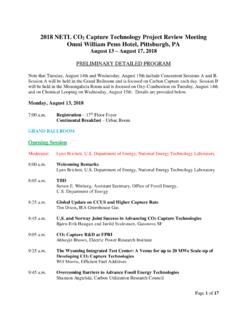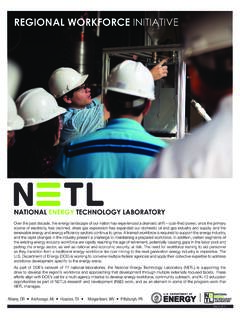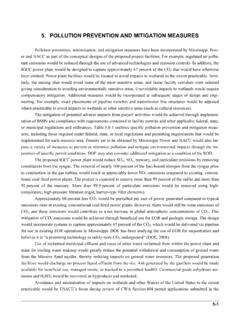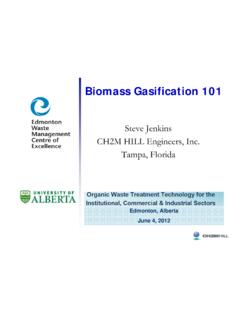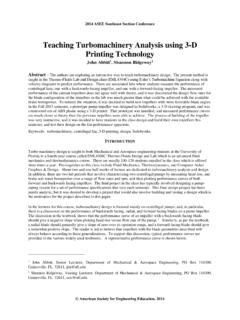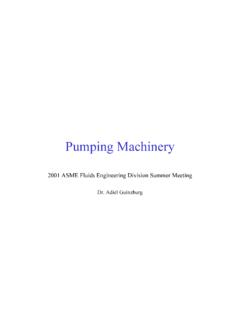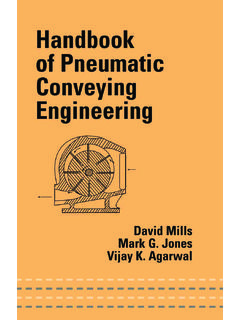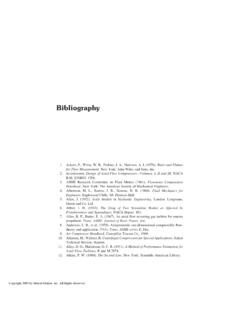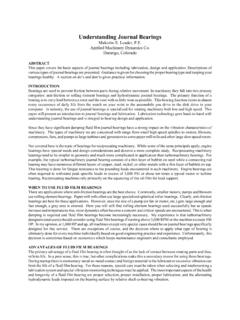Transcription of Cooled Gas Turbine Model - National Energy …
1 Cooled Gas Turbine ModelCan Uysal, PhDMentor(s): Dr. James Black, Eric LieseWVU Advisor: Dr. Andrew C. NixNovember 1, 2017An Analytical Model to Investigate the Effects of Different Cooling Techniques on Gas Turbine Performance2 Introduction theory and Development Cooled Turbine Model (CTM) Cooled Gas Turbine Model (CGTM) Sensitivity Analysis with CGTM The Effect on Performance from Different Blade Cooling ConfigurationsSchedule3 Project aims to develop an aerothermal engine Model that is capable of evaluating the impact of Different cooling configurations Seal Designs Purge Configurations Material properties Thermal Barrier Coatings Ultimate goal is to be able to identify and evaluate cooling technologies that will lead to >40% gas Turbine efficiency to support CC efficiency of 67%. The Model will also have the capability of analyzing the effects of pressure gain combustion, supercritical CO2turbines and cooling of the coolant flow on engine performanceIntroduction4 IntroductionThe location of Cooled Gas Turbine Model in Combined Cycle Performance CalculationsCooled Gas Turbine ModelCooled Turbine ModelCooling Correlations5 Literature Review of similar models indicate a general flowchart of such a Model should include 3 major Flowrates should be calculated based on cooling Analysis using these flowrates will give enthalpy Analysis using information from previous sections will give exergy informationCooled Turbine ModelTheory1 STLAW ANALYSIS-Enthalpy at each Turbine stageINPUTSCOOLANT CALCULATIONS-Overall Cooling Effectiveness-Coolant fractions2 NDLAW ANALYSIS-Entropies at each Turbine stage-Finds exit pressure with 2ndLaw using these entropies Cooled Turbine MODEL6 The Cooled Turbine Model repeats the previous analysis at each stage.
2 For each componentCooled Turbine ModelDevelopmentFOR EACH STAGELOOP ON STAGE PRESSURE RATIOHINGFOR EACH STAGE COMPONENTCOOLANT CALCULATOR1 STLAW ANALYSIS2 NDLAW ANALYSIS STAGE 1, 2ht,STAGE Calculated Turbine Pressure Ratio compared with fixed stage PR from turbomachinery Model Middle loop changes coolant-supply temp. until the correct stage PR is matchedUNCOOLED ENGINEVALUES & (TET) Cooled Turbine EXIT VALUES7 CooledGasTurbineModelcalculationsuseunco oledengineon-designandturbomachinerydesi gnsectionresults CGTM usesmethanecombustionthermodynamicproper tytablesgeneratedbyusingREFPROP1andGASEQ S oftware2 Cooled Gas Turbine Model (CGTM)eps1=coolant fraction used for stator cooling eps2=coolant fraction used for rotor cooling psi= coolant fraction used for transition cooling[1] National Institute of Technology (NIST), REFPROP Software using Standard Reference 23, Version [2] GASEQ Software-Chemical Equilibria in Perfect Gases by Chris Morley, < >8 CGTM calculates some of the essential turbomachinery information for cooling analysis such as stage velocity triangles, stage entry/exit flow angles, number of stages, stage pressures and temperaturesCooled Gas Turbine ModelGenerating turbomachinery Data9 ModeliscalibratedwiththreeH-classgasturb ines.
3 SiemensSGT6-8000H, ,andMitsubishiHeavyIndustriesM501J Cyclecalculationsandcomponentperformance resultswerevalidatedwithGasTurb12 Softwareviatestscomparestheoutputsoftwop rogramsside-by-sideforspecifiedenginepar ametersandtestscomparetheresponseoftwopr ogramstothesameinputparametervariedina predeterminedrange Numberofstages,bladeheightsanddiskdimens ionswereusedinturbomachinerydesignsectio nvalidationwithavailablepublicdataforthe selectedgasturbines Power,HeatRate,ExhaustTemperature,andnum berofstageswereusedwithengineparameterst omatchtherealenginedataCooled Gas Turbine ModelValidations10 Cooled Gas Turbine ModelCalibrationsSGT6-8000 HCGTMP ublished Value [1]Power296 MW296 MWThermal % Rate8526 Btu/kWh8530 Btu/kWhExhaust Temperature1159 0F1160 Value [1]Power347 MW346 MWThermal % Rate8084 Btu/kWh8080 Btu/kWhExhaust Temperature1153 0F1153 0F[1] Gas Turbine World, 2015 Performance Specs , 31st Edition, January-February 2015, Volume 45, , Pequot Publishing Inc.
4 [2] Siemens Global Website-Pressebilder, retrieved from []=PG [3] GE Power, Gas Turbines (60Hz) Fact Sheet 2016 , retrieved from on 08/16/2016[4] De-Centralized Energy Journal, 2010, Gas Turbines Breaking the 60% Eff. Barrier , , Issue 3, retrieved from < >[2][3]M501 JCGTMP ublished Value [1]Power327 MW327 MWThermal % %Heat Rate8325 Btu/kWh8325 Btu/kWhExhaust Temperature1178 0F1176 0F[4]11 Cooled Gas Turbine ModelValidations010000020000030000040000 0500000600000260028003000320034003600 Power (hp)Tt4 (R)Shaft Power (lbm/(hp-h)Tt4 (R)Power Specific Fuel (R)Thermal EfficiencyGasTurb12 CGTMP arameterDefinitionGasTurb12*CGTMUnit%Dif ferencemcTotal CoolantFlow Fraction (charged) cHCompressor Isentropic fuel-to air tHTurbine Isentropic tHTurbine Pressure Pressure Power Specific Fuel ( ) thThermal Rate85088537 Test Results for a generic H-Class engine scenario[*] GasTurb12 Software by GasTurbGmbH c/o Institute of Jet Propulsion and turbomachinery Templergraben55, 52062 Aachen, DeutschlandAinley, , (1957), Internal Air Cooling for Turbine Blades.)
5 A General design Survey , Aeronautical Research Council Reports andMemo. 301312 Sensitivity analysis on some general cooling input parameters of CGTM is made by using following variables: Blade Metal Material Properties (through reducing Bim and increasing max. allowable metal temperature(Tb,max) ) Thermal Barrier Coating Material Properties (through BiTBC) Internal Cooling Efficiency ( c) Film Cooling Efficiency ( fc) The effects of changing these parameters on gas Turbine key performance parameters (power, heat rate, thermal efficiency) were analyzed separately Sensitivities of the performance parameters on these cooling variables are found and a sensitivity chart is obtained for each performance parameter Details of this part is in ASME GT-63480* paper presented in ASME TurboExpo2017 Sensitivity Analysis[*] Uysal, S. C., Liese, , Nix, , and Black, , (2017), A Thermodynamic Model to Quantify the Impact of Cooling Improvements on Gas Turbine Efficiency , GT2017-63480, TurboExpo2017, Charlotte, NC 13 Sensitivity AnalysisThermal Efficiency-30-25-20-15-10-505101520-60-4 0-200204060%change in thermal efficiency% change in parameterSensitivity for Thermal Efficiency*Advancement in technologyHigher Slope=Higher Dependency[*] Uysal, S.
6 C., Liese, , Nix, , and Black, , (2017), A Thermodynamic Model to Quantify the Impact of Cooling Improvements on Gas Turbine Efficiency , GT2017-63480, TurboExpo2017, Charlotte, NC 14 In this section, an advanced coolant calculation algorithm is developed by combining the heat-exchanger method from Ainley*and Consonni**, with the existing semi-empirical method of CTM Values for and are calculated from different correlations and experimental/CFD data, respectively and used in an iterative calculation procedure on internal cooling effectiveness Users are allowed to specify a blade cooling configuration (both internal and external) to see the impact on engine performance New algorithm is modelled as a coolant calculator that replaces the existing one with the same outputs, but without changing the Cooled Turbine 1stLaw and 2ndLaw Analysis modulesThe Effect on Performance from Different Blade Cooling ConfigurationsIntroduction[*] Ainley, , (1957), Internal Air Cooling for Turbine Blades: A General design Survey , Aeronautical Research Council Reports andMemo.
7 3013[**]ConsonniS.,(1992) Performance Prediction of Gas/Steam Cycles for Power Generation , PhD Dissertation to Princeton University, Centerfor Energy and Environmental Studies151. Cooling flow is equally divided between the pressure and suction sides2. Blade curvature and compressibility effects are negligible 3. No flow and temperature variations along the radial direction ( adjacent blade strips)4. Cross-flow effects between adjacent strips are negligible5. All internal cooling segments will have the same cso that the coolant heating within the blade is same for all internal Coolant fraction required by the film cooling is supplied entirely by the internal cooling. The Effect on Performance from Different Blade Cooling ConfigurationsDevelopment of the Advanced Coolant Calculator-AssumptionsElement of analysis(repeated from hub to tip) adiabatic film cooling effectiveness for the blade strip can be obtained by the Seller s internal cooling Stanton number can be found by a weighted average based on the chord length fractions of each applied internal cooling losses in the cooling channels are included in the performance calculations by the entropy loss term for internal friction [*] Uysal, S.
8 C., (2017), Analytical Modelling of the Effects of Different Gas Turbine Cooling Techniques on Engine Performance , PhD Dissertation, West Virginia University, ProQuest Publishing, Ann Arbor, MI16 The NTU equation obtained by Consonni** is transformed in this algorithm to calculate the coolant fraction with known NTU Where NTU is known from re-arranging the result of the heat exchanger analysis by Ainley*, with c,extcalculated by using the cand 1D HT schemeThe Effect on PerformancefromDifferentBladeCoolingConf igurationsMethodology = 4 ( 111 + , , = 1 , , , , The value of , is dependent on the cooling technology applied and can be found from using the Biot number and effectiveness definitions: The outer wall temperature Twis dependent on the application of film cooling [*] Ainley, , (1957), Internal Air Cooling for Turbine Blades: A General design Survey , Aeronautical Research Council Reports andMemo.)
9 3013[**]ConsonniS.,(1992) Performance Prediction of Gas/Steam Cycles for Power Generation , PhD Dissertation to Princeton University, Centerfor Energy and Environmental Studies17 The Effect on PerformancefromDifferentBladeCoolingConf igurationsAlgorithm[*] Uysal, S. C., (2017), Analytical Modelling of the Effects of Different Gas Turbine Cooling Techniques on Engine Performance , PhD Dissertation, West Virginia University, ProQuest Publishing, Ann Arbor, MI18 The Effect on PerformancefromDifferentBladeCoolingConf igurationsInternalandExternalCoolingCorr elations19 User enters an internal cooling schedule indicating cooling types: [LE, MC, TE]1x3 Algorithm picks the regarding correlation for each blade segment and calculates a local Stanton number Local Stanton numbers are then span-averaged by using chord length as a weighting factor to obtain This value is then used in the iterative coolant calculation procedure The Effect on PerformancefromDifferentBladeCoolingConf igurationsInternalCoolingSubsytem20 In the external cooling sub-system, the film cooling efficiencies that are obtained either through experiments or CFD is used to obtain blade average adiabatic film cooling efficiency ( ) Based on the number of cooling hole rows, algorithm distributes the holes over the chord evenly After distributing the holes over the chord, algorithm picks the corresponding span averaged effectiveness data set (from experiment or CFD)
10 For the specified hole type and blowing ratio Effectiveness data is read up to the x/d location that corresponds to the location of the next cooling hole Algorithm calculates an average span-averaged adiabatic film cooling effectiveness value by using Seller s Method* The Effect on PerformancefromDifferentBladeCoolingConf igurationsExternalCoolingSubsystem , / = =1# , =0 1(1 , )[*] Sellers, J. P., Jr., (1963), Gaseous Film Cooling With Multiple Injection Stations, AIAA J., 1(9), pp. 2154 215621 With the existing internal and external cooling correlations and CFD data built-in to the advanced coolant calculator, it is possible to analyze 1024 logical blade cooling configurations To determine the analysis cases, the blade internal cooling configurations were determined from the configurations mostly used in recent advanced gas turbines: LE Impingement, Mid-Chord Ribs, TE Pin-Fins The effect of the effects of film cooling hole type, mid-chord internal cooling type, trailing edge internal cooling type, and the number of film cooling rowswereanalyzed The base cooling analysis inputs used for this analysis are determined from typical values used in advanced blades from Town et al.
